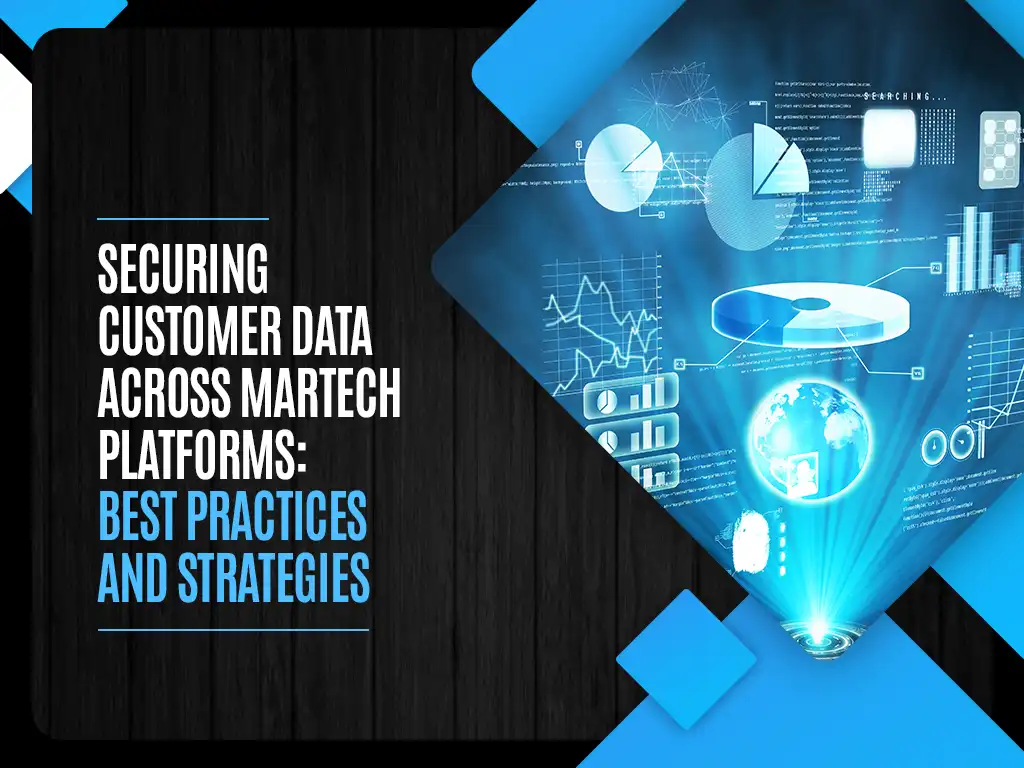Securing Customer Data Across MarTech Platforms: Best Practices and Strategies
Learn best practices and strategies for securing customer data across MarTech platforms, ensuring privacy, compliance, and data integrity.

MarTech, or Marketing Technology, is the highly evolving space that is transitioning the outlook of the entire business market and product advertising. It comprises the software and tools utilized across digital marketing, including tracking and analytic services, lead-scoring tools, and customer engagement platforms. The better augmentation of digital media, automation abilities, and data-driven insights help marketers reach greater heights to attain customer loyalty and engagement.
Irrespective of the different perks of the offerings in MarTech advancements, security threats are becoming the core part of this equation. The reason behind every MarTech tool depends mainly on data that is protected at all times, ensuring better business integrity and safeguarding customer data.
In our post today, we will examine the best strategies and practices for mitigating security risks involving the implementation of robust third party risk management services.
What is MarTech?
MarTech, or marketing technology, is a software stack facilitating and executing varied marketing activities. Marketers often use it for working efficiently, communicating, and scaling their efforts. The collective tools used by a department or team are considered the MarTech stack. These are the tools being used collectively to boost and optimize the content and innovative workflow. After you have the right tools, you still have to assemble a proactive martech team to operate them. It is through here that your martech stack and team evolve combinedly, delivering the complete perks of your technology.
Overview of Martech Security
Proper security of marketing technology platforms can help safeguard the systems and data being used in marketing technology. This comprises software applications, databases, customer engagement platforms, and analytics tools. The real objective of securing the Marketing Technology platform is to ensure that marketing data is transmitted across digital networks safely and confidentially.
Robust security practices like third—or fourth party risk management should be in place. However, it is common for businesses to choose managed services that offer affordable, extensive security assurance and coverage. For instance, businesses today can attain IT consulting for cloud infrastructure and cybersecurity, ensuring the safety of the MarTech platforms.
Best Practices for Martech Security
Safeguarding the data of the MarTech platform is the key to business success in terms of maintaining trust with its customers. Let’s now examine the ideal practices concerning this security.
Screening Third-Party Tools & Platforms
Marketers’ real weapon has expanded over recent times with specialized tools that help in data capture, campaign operation, predictive analysis, branding, and promotion. Several tools and platforms are distributed across SaaS format and cloud storage, adding to the security intricacies connected to them.
Reportedly, the average cost of data breaches across global businesses amounted to $4.45 million. A leaked data cost about $165. Here, the United States witnessed the highest average breach that globally cost $9.48 million. These recorded numbers shifted the organizations to imply two-factor authorization across their business processes dealing with external parties.
Every new third-party platform and service undergoes a strict security assessment that requires a complete examination of the SLA with service providers. The assessment mentions the use of data and its ownership, along with the liability clauses in case of breach. Ensure that greater segmentation is included in the storage between varied clients.
Partner With Security Experts
Cybersecurity is an extremely challenging subject that requires expert help. Associating with a third-party cybersecurity team helps ensure that the MarTech platform is safe from notable security threats like ransomware attacks, data breaches, and phishing scams.
The primary perk of using the external security team is that they are offering daily updates for staying abreast of the latest threats and countermeasures. Furthermore, they would automate the audit trails, compliance management processes, and log reviews, offering extensive coverage options.
Strict Access Control
Organizations have started to gather possible data from customers with big data. Consumers are gaining more concern about their privacy and legal interventions such as CCPA and GDPR, with some coming into effect globally to keep the firms responsible for handling every private data. Numerous marketing departments get used to multiple users handling similar accounts with shared credentials with a few of the people who have even left the firm.
The default access control strategies need to be conservative, using the principle of minimum privilege. The master account would help control and monitor numerous individual accounts across different platforms and tools. Two-factor authorization should be used for accessing and changing passwords periodically. A systematic process is required for identifying end-of-life data and executing a proper data strategy.
Use Multi-Factor Authentication
MFA, or Multi-Factor Authentication, requires users to offer two or more pieces of proof before getting access. This is mainly after entering the password, where you can use biometric authentication like facial recognition, fingerprint, security codes, and questions.
MFA offers an additional layer of protection, ensuring only authorized personnel access the Martech platform. Even if the passwords are compromised, the intruder only gains entry with additional authentication to safeguard your data.
Ensure Vendors Put Security First
Another way to safeguard your MarTech platform against data breaches is to ensure that the vendors with whom you work emphasize cybersecurity. This means inspecting whether the third-party services adhere to industry regulations and best practices for data protection.
Since most MarTech solutions are offered on a SaaS basis, it is best to audit the different security measures used by the vendors to ensure that no data breaches are taking place.
Consolidate Data On the Customer Data Platform (CDP)
CDP or customer data platform would start to consolidate different customer data into a single storage. It imposes better access and management of data and tracking customer behavior seamlessly across different channels. It allows businesses to precisely process, store, evaluate, and use customer data.
The CDPs are designed appropriately to secure and comply with industry regulations. They offer features like data masking, encryption, access control, and anomaly detection, ensuring the top-level security of customer data stored in the system.
Regularly Confirm Martech Stack Compliance
It is important to regularly inspect whether MarTech complies with industry standards and regulations like GDPT or General Data Protection Regulation. This requires assessing different processes and activities related to data protection in the company. For instance, a cybersecurity audit or evaluation of enterprise risk can help identify possible security weaknesses.
It is the step that evaluates the transitions across the privacy laws that impact the manner in which the MarTech platform operates and ensures the appropriate security measures are implemented to safeguard customer data.
Conclusion
Cyber threats are constantly evolving across the technological space. Ensuring the security of the MarTech platform is never a single-moment task, as there is not any one strategy that meets every process. We have to continue to learn more about the latest threats to make the required changes to the different security measures.
Author Bio:
Nagaraj Kuppuswamy is the Co-founder and CEO of Beaconer, an esteemed enterprise specializing in managed third-party risk using the cloud-native AI-based solution. With an extensive portfolio of accolades and industry certifications, Nagaraj stands out as a seasoned expert, boasting over 16 years of dedicated involvement in the field of Cybersecurity. Throughout their career, he has predominantly focused on elevating the realm of third-party risk assessment. You can connect with him through Linkedin.



